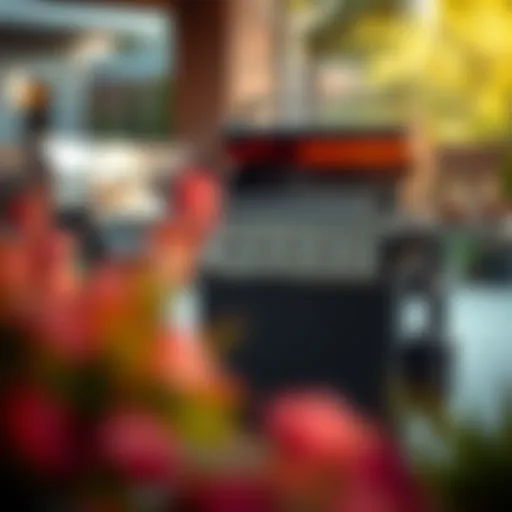Understanding Christmas Lighting Costs and Influences
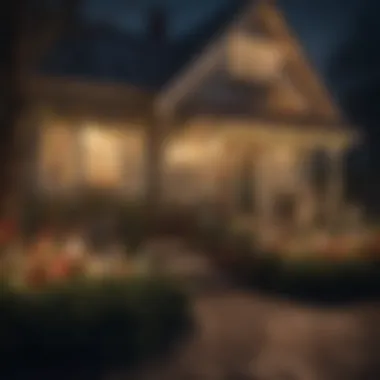

Intro
As the festive season approaches, many homeowners dive into the joy of decorating, and incorporating Christmas lights is often at the forefront of their minds. However, as delightful as it is to see homes aglow with twinkling lights, the costs associated with such festive adornments can vary greatly. Understanding these costs is crucial, not just for budgeting but also for selecting the right kind of lighting that fits both style and budget. This article encapsulates the nuances behind Christmas lighting expenses, bridging the gap between aesthetics and financial planning.
Design Inspirations
Christmas lighting is more than just illuminating your home; it’s about creating a warm and inviting atmosphere that harmonizes with your overall holiday decor. Here, we delve into the popular design inspirations that homeowners often consider while decking the halls.
Trending Styles
In recent years, trends in Christmas lighting have shifted dramatically. Traditional string lights remain a classic choice but have now evolved into a myriad of options. For instance, LED strip lights have gained momentum. These flexible, low-energy lights can be placed almost anywhere, giving homeowners the freedom to be creative with their displays.
Another popular style is projector lights, which can cast sophisticated images like snowflakes or holiday motifs onto the sides of homes. This modern twist allows for quick setups with a big impact. Moreover, solar-powered lights have emerged as eco-friendly options, making it easier to celebrate while being kind to the planet.
Color Palettes
Choosing the right color scheme can change the entire vibe of your decorations. While warm white lights lend a cozy and sophisticated ambiance, vibrant multicolored lights inject a sense of playfulness and festivity. Homeowners often mix and match colors to create unique designs, aligning with personal tastes or neighborhood themes.
"Selecting the right colors involves not just preference; it’s about creating a cohesive look that enhances your home’s architecture and landscape."
Popular palettes like red and green for that classic Christmas feel, or blue and silver for a more modern approach, provide endless possibilities in creating a dazzling display.
Maintenance and Upkeep
After the lights are strung up and the holiday cheer is in full swing, maintenance deserves attention. Like any adornment, keeping lights in shape ensures longevity, allowing them to shine bright for many seasons.
Seasonal Maintenance Checklist
Regular checks are crucial during the holiday season. Here are essential tasks to consider:
- Inspect lights for damage or frays
- Ensure all connections are secure
- Change any burnt-out bulbs immediately
- Look for signs of moisture or corrosion in plugs
Maintaining your decorations throughout the holiday can significantly extend their lifespan.
Cleaning and Organization Tips
Once the holiday cheer fades, it's time to take down the lights. Here's a straightforward approach to ensure they stay in good condition:
- Use storage bins: Store lights in labeled bins to avoid tangled messes.
- Wrap carefully: Avoid knotting by loosely wrapping lights around cardboard or using hangers.
- Evaluate broken items: Last but not least, always take stock of which lights need replacing for the next year.
Understanding Christmas Lighting Costs
Christmas lighting costs can make or break a holiday budget, especially when it comes to creating that picture-perfect festive atmosphere. In this article, we’ll dive into the various influencing factors that can impact these costs, helping you make informed choices without losing sight of what’s truly important: family, friends, and the memories created during this special time of year.
Knowing the basics of Christmas lighting costs can elevate your holiday experience from ordinary to extraordinary. It’s not just about picking the right colors or what looks pretty; it’s equally about understanding how much you’ll have to fork out, what kinds of materials are available, and how these choices will affect both your budget and the overall look of your decorations. This understanding can save you from unpleasant surprises that could dampen your holiday cheer.
An Overview of Seasonal Lighting
As the holiday season sweeps in, many homeowners start to dig out their beloved Christmas lights, sometimes even sifting through tangled strings they put aside last year. Seasonal lighting’s become more than just a trend; it’s almost a rite of passage for welcoming winter festivities. From the colorful strings adorning rooftops to the classic white lights lining the sidewalks, the options available are enormous.
But it’s not all about whimsy and aesthetic appeal. Seasonal lighting can actually influence the mood of your gatherings. You can think of it as a way to set the stage or create an ambiance that brings your community together, sparking joy and nostalgia every time someone strolls by.
"Lighting not only enhances the aesthetic appeal but can also weave together a community spirit during the holiday season."
When contemplating your lighting options, it’s useful to consider the kind of message you want to send. Are you going for a festive feel, or a more elegant and subdued ambiance? Each of these choices will reflect different costs based on the types of light you pick. The difference between incandescent and LED lighting isn’t just that of brightness; it also resonates in your wallet for years to come.
Budgeting for Holiday Decor
Budgeting for Christmas lighting requires a careful balance between the desires for elaborate displays and being fiscally responsible. It’s easy to get swept away with ambitious ideas that seem charming but might come with a hefty price tag. To help manage this, lay out a budget ahead of time. That means considering:
- Types of Lights: Traditional incandescent bulbs might seem cheaper upfront, but LED options could save you money in the long run with reduced energy costs.
- Coverage Area: Measure the areas where you intend to put your lights. Knowing square footage can help you avoid overspending on excess lights or underestimating the amount needed.
- Installation: Whether you’re opting for DIY or hiring professionals, installation costs can add up quickly. Get quotes ahead of time if you're leaning towards hiring help.
A practical approach is to assign a percent of your budget to lights, along with other holiday decorations like wreaths, ornaments, and yard decor. This can help distribute your funds effectively, avoiding a last-minute scramble. Moreover, don't forget to account for potential seasonal discounts or sales, which could lighten the financial load considerably.
Son’t shy away from discussing your lighting ideas with family or friends. Pooling resources for a communal display can both lower expenses and create a collaborative environment. It adds an element of shared joy, transforming the holiday spirit into something more than just individual effort.
In summary, understanding the costs and budgeting appropriately for Christmas lighting not only results in financial savings but also enhances the joy of the holiday season, creating a beautiful setting to celebrate with loved ones.
Types of Christmas Lights
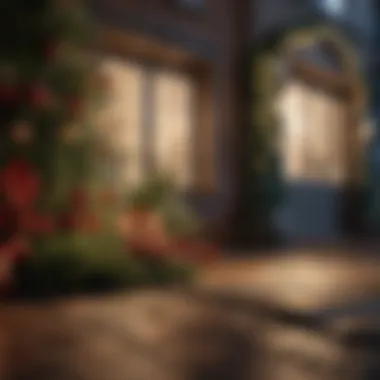

When it comes to illuminating your home during the holiday season, the types of Christmas lights you choose can greatly influence both the aesthetic appeal and overall cost of your decor. With a variety of options available today, each type brings its own set of benefits, challenges, and nuances. Understanding these differences not only helps in achieving a desired look but also plays a crucial role in your budgeting and planning efforts.
The choice of lighting can transform a mundane landscape into a festive wonderland, and meticulous consideration of these lighting types is essential in maximizing both enjoyment and cost-efficiency.
Traditional String Lights
Traditional string lights have been a staple holiday decoration for decades. Often viewed as classic and warm, these lights are typically available in various colors and bulb sizes. They evoke nostalgia, recalling childhood memories for many individuals during the holiday season.
However, while they may create a charming atmosphere, these lights do come with some drawbacks. For instance, incandescent bulbs are notorious for their energy consumption. Compared to more modern alternatives, they can lead to higher energy bills throughout the season. This sobering fact should weigh into your decision-making regarding string lights.
In terms of installation, traditional string lights are often straightforward, requiring simple hooks or clips for placement. Their versatility allows them to be draped along rooftops, wrapped around trees, or even strung across patios, but proper care is necessary to prevent potential hazards such as overheating or fire risks.
"There’s a special kind of warmth that comes with classic string lights, but don’t let that fool you – keep an eye on those energy costs!"
LED vs. Incandescent Lighting
The debate between LED and incandescent lighting continues to evolve, impacting both cost and energy use. On one hand, LED lights have stormed the market as the eco-friendlier alternative. They last significantly longer than incandescent bulbs and consume substantially less electricity, often translating into lower long-term costs despite the initial higher purchase price.
On the other hand, incandescent lights tend to be less expensive upfront, but their short lifespan and increased energy consumption can quickly add up, especially when used extensively during the holiday season.
Homeowners must also consider the quality and warmth of the light emitted. Some find the cool, bright glow of LED lights to be too stark for holiday settings, while others appreciate the modern feel. Testing a few options may yield the best fit for your aesthetics and budget.
Specialty Lighting Options
Specialty lighting options include a broad range of choices that can bring creativity and unique flair to your holiday decor. From projection lights that create whimsical patterns on homes to novelty shapes that catch the eye, the possibilities are endless.
For instance, net lights can easily cover bushes or trees, while icicle lights create a stunning downward cascade effect reminiscent of winter wonderlands. Battery-operated lights also offer flexibility in terms of placement, eliminating the need for cumbersome extension cords.
However, while investing in these specialty items can enhance your display, it's wise to consider costs closely. Some of these lights can carry higher price tags than traditional options and might necessitate significant upfront investment.
Navigating this landscape of lighting options requires weighing the impact on your budget against the visual appeal intended for your holiday celebration. Carefully assessing these various types affords you the ability to curate a space that resonates with your unique taste while keeping costs under control.
Factors that Influence Costs
When it comes to illuminating our homes during the festive season, the cost can be quite a puzzle for many homeowners. Understanding the various factors that influence these expenses is paramount in crafting a beautiful display without breaking the bank. Here, we delve into the key elements – quality of materials, length and coverage area, and installation complexity – that can have both a noticeable and subtle impact on your wallet.
Quality of Materials
The adage, "you get what you pay for," rings especially true in the realm of Christmas lighting. The material's quality affects not only the upfront cost but also the durability and efficiency over time. For instance, investing in LED lights can initially feel like a steep hill to climb, as they are more expensive than traditional incandescent options. However, this upfront cost tends to pay dividends over time through lower energy bills and a longer lifespan.
- LED versus Incandescent: While incandescent bulbs are often cheaper, they consume more energy and burn out faster. In contrast, LEDs have a significantly longer life and can be used throughout multiple seasons. As a result, many savvy decorators are willing to shell out a bit more at the checkout to save money over the years.
- Material and Design: Beyond just type, consider the materials used in construction. Weather-resistant features can protect the lights from the elements. This investment leads to fewer repairs and replacements, maintaining the beauty of your decor for the long haul.
Length and Coverage Area
The size of your lighting project undeniably determines a chunk of your total cost. Homeowners often face the challenge of calculating how many strands are needed to achieve that dazzling look without overshooting their budget.
- Calculating Length: Measure the areas where you plan to hang lights. Consider using a project-specific approach, meaning you should calculate the linear footage based on the layout of your property to avoid purchasing excess materials. Knowing your landscape helps to lock in length, leading to more precise budgeting.
- Coverage Area Costs: Don’t just count the linear feet of your house—think about vertical spaces too, like trees or other architectural features. The more extensive the coverage area, the higher the cost. People often find that cascading lights on trees creates a breathtaking focal point, though it may require additional strands.
Installation Complexity
Now, if you’re rolling up your sleeves and diving into DIY installation, then you’ll need to factor in the complexity level of your project. Simple, straightforward displays tend to be less costly due to less time and fewer resources needed. However, more intricate designs will require advanced tools and skills - which can escalate costs.
- DIY vs. Professional: Making the choice between installing your lights or hiring professional help can also vary the price dramatically. A simple installation may present little more than labor for your time, while intricate patterns could require professional assistance. Remember, it's not just about the installation; how quickly you can safely put up your lights is key.
“Planning ahead is key. Understand your costs before you light up the night!”
By weighing the quality of materials, calculating the correct length for coverage, and assessing installation complexity, you position yourself to enjoy the holidays fully without unpleasant financial surprises.
Pricing Trends in Christmas Lighting
When it comes to illuminating our homes during the festive season, pricing trends in Christmas lighting carry significant weight. Understanding these trends not only helps homeowners manage their budgets more effectively but also guides them in making informed decisions about the types of lights they choose to incorporate into their displays. The fluctuations in prices can arise from a variety of factors, including supply chain dynamics, seasonal demand, and advancements in lighting technology.
Awareness of pricing trends enables consumers to plan their purchases strategically, taking advantage of discounts and sales cycles. For example, the moment Halloween wraps up, many retailers start offering Christmas lighting products, often at lower prices compared to the weeks leading up to Christmas. Therefore, savvy shoppers can enjoy some substantial savings by purchasing early.
Additionally, seasonal sales events like Black Friday and Cyber Monday have been known to provide excellent opportunities for cost-effective shopping. When homeowners keep an eye on these pricing trends, they can save money without compromising on the quality or aesthetic appeal of their holiday decorations.
Average Cost Estimates
Navigating the world of Christmas lighting involves understanding average cost estimates, which can vary widely based on several influential components. Most residential users can expect to spend anywhere from $100 to upwards of $500 on decorations, depending on their choices of lights and installation methods.
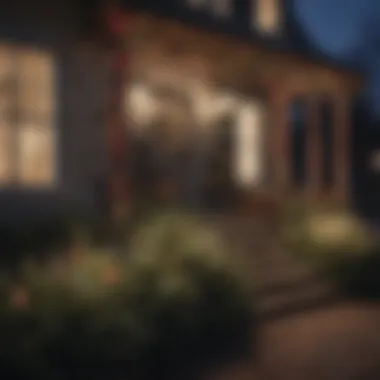

Key Factors Affecting Average Costs:
- Type of Lighting: LED lights usually come at a premium upfront but offer benefits in energy efficiency and longevity. Incandescent options are cheaper initially but consume more energy, leading to higher bills in the long term.
- Coverage Area: The size of the area being decorated will play a huge role in overall cost. Larger areas naturally require more lights, leading to additional expenses.
- Quality and Brand: Higher-quality lights from reputable brands tend to cost more but often translate into longer-lasting results, potentially saving money on replacements down the line.
For example, you might find that a string of basic incandescent lights runs around $20 for a 100-bulb set, whereas a comparable length of LED lights can cost around $50. The difference in durability and energy use can be worth considering as part of the overall cost.
Seasonal Discounts and Sales
Keeping an eye on seasonal discounts and sales can lead to considerable savings when it comes to Christmas lighting. Retailers frequently offer markdowns during key shopping events, which can significantly lower the costs associated with holiday decor.
Some noteworthy sales periods include:
- After-Christmas Sales: Many retailers aim to clear their inventory, leading to prices slashed by up to 50% or even more. This is a great time to stock up for the following year.
- Black Friday/Cyber Monday: These annual shopping events have become synonymous with massive savings on all kinds of home decor, including Christmas lights.
- Clearance Events: Mid-December often sees stores trying to move their remaining stock before the holiday season passes, resulting in deep discounts.
"Timing your purchases can mean the difference between a great deal and overpaying for decor that will be in storage for the next 11 months."
Overall, staying informed about these sales can empower homeowners, allowing them to decorate their spaces beautifully while keeping an eye on their budgets.
DIY vs. Professional Installation
In the world of Christmas lighting, one major choice stands out for homeowners: tackle the installation themselves or hire a professional. This decision can greatly influence not only the aesthetic charm of a home during the festive season but also the overall cost involved. Let’s break it down a bit.
Cost Comparison
When it comes to the wallet, DIY looks like a tempting route. Generally speaking, handling the lights yourself can save quite a few bucks. You’ll need to factor in the cost of materials such as strings of lights, clips, extension cords, and, of course, those quirky decorations that catch your eye. Depending on the scale of your installation, a DIY approach can range from $50 to a couple of hundred dollars.
On the flip side, professional installation comes with its own price tag. Hiring experts might set you back anywhere from $200 to over $1,500, depending on the complexity and size of the display. While it might be a heavier hit on the budget initially, consider the potential peace of mind, especially if climbing a ladder isn't your strong suit.
"The cost of DIY might seem lower at first, but understand the value of your time and safety before deciding."
Skill Level Requirements
Understanding your own capability is key when considering the DIY route versus calling in the pros. DIY installation often requires basic skills—like climbing ladders and working with electrical components—not to mention creativity to design a stunning display. If you're handy and have experience with holiday décor, you might be quite comfortable stringing lights up yourself. However, some aspects can be trickier than they seem.
For those with minimal experience, the learning curve can be steep. Mishaps such as tangled lights or unsafe installations can lead to even larger costs, either from damage or hazards.
Conversely, professionals come equipped with significant expertise. They know all the tricks of the trade. From designing an eye-catching layout to ensuring safe electrical practices, their skills often outweigh the additional cost. When in doubt, asking yourself if you enjoy the task or view it as merely an obligation can help steer your decision toward the right choice.
Ongoing Maintenance and Storage
When it comes to Christmas lighting, the excitement of putting up the decorations can sometimes overshadow the black-and-white realities of ongoing maintenance and storage. This aspect is critical in ensuring your festive lights not only shine brightly throughout the season but also remain in tip-top condition for years to come. Proper care can significantly save homeowners from unexpected expenses related to repairs or replacements.
Post-Season Storage Solutions
After the holiday season wraps up and the lights are taken down, how you choose to store them can determine their longevity. Storing lights properly is like putting them in a time capsule; thoughtful preservation can mean less hassle next year.
Here are a few storage tips to keep in mind:
- Use Original Packaging: If you've kept the boxes your lights arrived in, that's often a great place to start. They’re designed to be snug and fit well.
- Wrap Carefully: For those lights lacking original boxes, consider wrapping them in plastic or paper to avoid tangling. Cable ties or rubber bands can help keep them organized.
- Cool and Dry Location: Humidity can be the enemy of electrical components. Store your lights in a dry space, away from places where they can be exposed to moisture. A basement might work unless it’s prone to flooding or dampness.
Also, some folks prefer using plastic bins, labeling them according to type or color of lights, making it much easier to locate specific sets when the season rolls around again.
Maintenance for Longevity
Once your lights are securely in storage, it’s tempting to take a long breather from all things Christmas. But maintenance does not just involve how you store them, it’s about the upkeep that prolongs their lifespan during use as well.
Here are some practices to keep your lights gleaming for years:
- Regular Inspections: Before installation, take time to check for broken bulbs or damaged wires. It’s better to find these issues before you hang them up.
- Cleaning Routine: Dust and dirt can accumulate on lights when stored. Use a soft cloth to wipe them down, which not only keeps them looking fresh but helps them service well through their use.
- Test before Hanging: Don’t just plug them in once they’re on the roof or tree. Test the lights while they are on the ground. If they flicker or don’t light up completely, you can deal with them easily without the hassle of taking them down later.
By embracing these practices, the time and effort put into maintaining your ornaments will yield results beyond mere aesthetics; they will extend the functionality and vibrance of your Christmas lighting.
"Storing lights properly is like putting them in a time capsule; thoughtful preservation can mean less hassle next year."
Overall, both ongoing maintenance and strategic storage are essential for maximizing the long-term value of your Christmas lighting investments. Understanding and implementing these steps leads to less waste and lower costs, brightening up the festive mood with every twinkle.
Energy Efficiency Considerations
When it comes to illuminating your home during the festive season, energy efficiency is a vital point to ponder. With mounting energy bills and environmental concerns, homeowners are increasingly drawn to lighting choices that not only sparkle but also save. These considerations are not merely about keeping the lights on; they play a crucial role in the overall cost-effectiveness and sustainability of Christmas decorations.
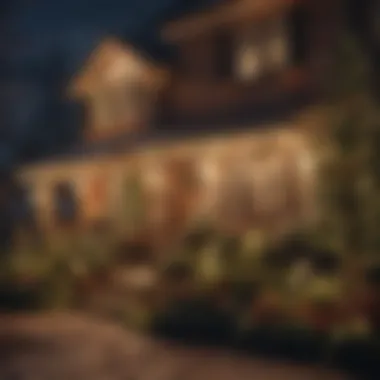

Impact of LED Lighting
LED lighting has transformed holiday decorations, bringing a host of benefits that extend beyond their initial cost. Unlike traditional incandescent bulbs, which consume more power and generate heat, LEDs use significantly less electricity. This reduction in energy consumption translates to lower utility bills, especially during the long nights of December.
One must consider the following benefits of LED lights:
- Longevity: LEDs last up to 25,000 hours, which is many times greater than incandescent lights. This durability means fewer replacements and waste over time.
- Color Variety: Modern LED options come in an array of colors and styles, making it easier to achieve that dreamy look you envision for your holiday decor.
- Heat Emission: Because they don’t heat up, LEDs are safer when placed in close proximity to flammable materials. This feature is especially important in a home full of festive flammable decorations.
Consider this: switching to LED lights can cut your Christmas lighting energy usage by about 75-80% compared to traditional incandescent lights. So, if you want to keep your wallet happy while dazzling friends and family with an epic light display, investing in higher-quality LEDs is a no-brainer.
Seasonal Energy Consumption Patterns
During the holiday season, the energy consumption patterns in homes can shift significantly. Many households leave their lights on from dusk until dawn, leading to noticeable spikes in energy usage. It’s essential to be aware of these patterns to avoid a nasty surprise when the electricity bill comes in.
A few factors to keep in mind:
- Runtime: If you’re running your decor lights for eight or more hours a night, those watts add up quickly. A careful look at your lighting schedule can make a big difference.
- Smart Technology: Consider utilizing timers or smart switches. These allow you to control when the lights turn on and off, avoiding unnecessary energy drain.
- Usage Habits: Don't forget that your energy consumption depends on how often these lights are used across the entire holiday season. Track your usage to better plan and optimize your layout.
"Understanding your energy usage during the holiday season can help you make informed decisions, ensuring that your beautiful lights do not result in a less-than-festive utility bill."
Ending
Navigating energy efficiency in your Christmas lighting not only fulfills a desire for aesthetic appeal but also aligns with modern sensibilities regarding sustainability and economization. By prioritizing LED technology and being mindful of seasonal consumption habits, you can create an enchanting light display that won’t leave your bank account in the dark.
Local Regulations and Permits
Understanding the local regulations and permits related to Christmas lighting can often be overlooked in the joy of holiday preparations. However, these guidelines can be vitally important for ensuring that your festive displays are safe, compliant, and harmonious with community standards. Ignoring them might lead to unexpected fines or dismantling of your display right in the midst of the season, which nobody wants.
Understanding Local Guidelines
Before you dive into stringing up your lights or putting up your impressive inflatable Santa, it’s beneficial to familiarize yourself with the specific regulations in your locality. Different areas may have rules addressing:
- Height Restrictions: Some municipalities enforce limits on how tall your displays can be. If you aim to have a loveable giant Frosty, check the height guidelines before you start your build.
- Prohibited Lighting Colors: There can also be restrictions on certain colors of lights due to local aesthetic or safety standards.
- Timing Restrictions: Noise ordinances or curfews might dictate when you can turn your decorations on or off. Ensure you're not lighting up the neighborhood all night long if your town doesn't allow it!
Be sure to check your local government’s website or contact your municipal office for the most accurate information. Keeping this knowledge at hand can give you peace of mind as you deck your halls.
Required Permits for Large Displays
If your Christmas display is beyond the typical festive lights and includes larger features, such as life-sized figures or heavy installations, you may need to obtain permits. Not only does this ensure legal compliance, but it can also protect you in case of accidents or damage.
Typically, the following considerations come into play when obtaining permits:
- Structural Safety: Depending on how you plan on installing your lights and decorations, they may need to be evaluated for safety. The last thing you want is for your impressive light display to collapse under the weight of snow or high winds.
- Utility Companies Notifications: If your display encroaches on utility lines or public properties, it's often required to let the local utility companies know. It's better safe than sorry—no one wants a blackout during a holiday party because of misplacement of lights.
- Specific Display Size Regulations: As mentioned, large displays often come with specific regulations to ensure they don't become traffic hazards or distract drivers. The community’s safety is always paramount.
"Regulatory guidelines are there not to dampen your holiday spirit but to foster communal joy in a safe and enjoyable environment."
In summary, while the festive cheer can cloud practicality, navigating through local regulations and permits can save homeowners from potential headaches later. Ensuring your decorations remain within the bounds of the law allows everyone to fully enjoy the holiday lights—and that’s truly worth its weight in golden tinsel.
Final Thoughts on Christmas Lighting Expenses
When it comes to Christmas lighting expenses, there's more than meets the eye. As the holiday season approaches, many are filled with joy at the thought of transforming their homes into glittering spectacles. But beneath this festive surface lies a complex web of choices, each with its own cost implications. Understanding these nuances is essential for any homeowner, especially those looking to strike a balance between beauty and budget.
Balancing Aesthetic Appeal and Cost
Striking the right balance between aesthetic appeal and cost is no small feat. Homeowners often find themselves torn between wanting to display a lavish light show and keeping their budget in check. The good news is that a well-planned display can achieve that seasonal sparkle without making your wallet weep. Prices can vary widely depending on the type of lighting used, the scale of the display, and installation options.
For instance, opting for energy-efficient LED lights can save dollars in utility costs over time, providing a win-win scenario. Here are some key pointers for keeping your display dazzling yet cost-effective:
- Choose LED over incandescent lights: They last longer and consume less energy, saving you money in the long run.
- Start small: If you're on a tight budget, begin with one area of your home and gradually expand in future years.
- DIY installation: If you have some basic skills, do it yourself. It's amazing what you can accomplish with a little creativity and elbow grease.
Ultimately, the aim is to create an inviting atmosphere without compromising one's financial wellbeing. A little foresight can go a long way in crafting a stunning yet sensible holiday display.
Planning for Future Projects
Thinking ahead is paramount when it comes to Christmas lighting. Whether you're eyeing a temporary setup for one season or planning an elaborate arrangement that could last several years, foresight can save time and expenses in the long haul. As tastes and technology evolve, so can your holiday displays.
Consider these elements when planning for future projects:
- Invest in quality: High-quality lights may seem pricier upfront, but their durability can pay off.
- Keep an eye on trends: Each year brings new trends in holiday decor. Staying informed keeps your lighting fresh and exciting.
- Budget for maintenance: As with any seasonal decor, maintenance costs like replacing bulbs or repairing damaged wires add up. Factor this into your overall budget from the start.
In summary, thoughtful planning can alleviate the stress that comes with holiday lighting. By understanding your goals, tastes, and budget, you can create a lighting display that truly shines. Taking the time to review these elements now allows homeowners not only to enhance their holiday spirit but also to ensure every light is worth its weight in festive cheer.
"The secret to a beautiful holiday display lies not just in the lights, but in the planning behind it."
By keeping these factors in mind and making informed decisions, anyone can create a Christmas lighting experience that is both enchanting and manageable. After all, what’s a little glow without the understanding of its costs?



